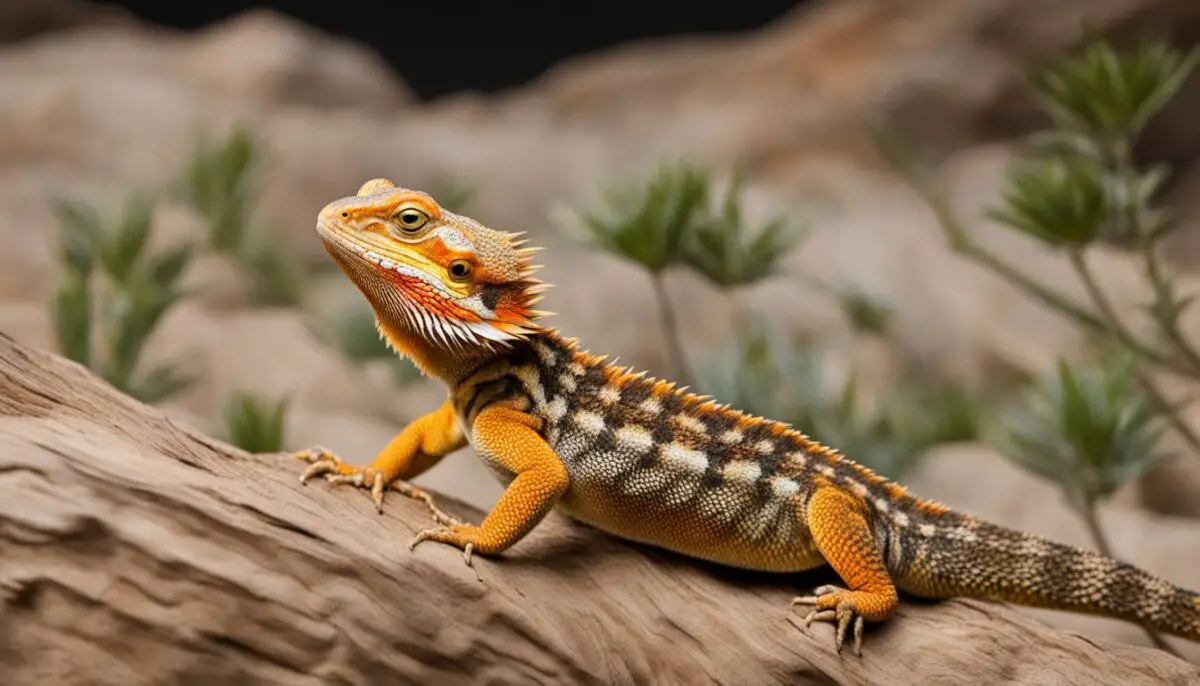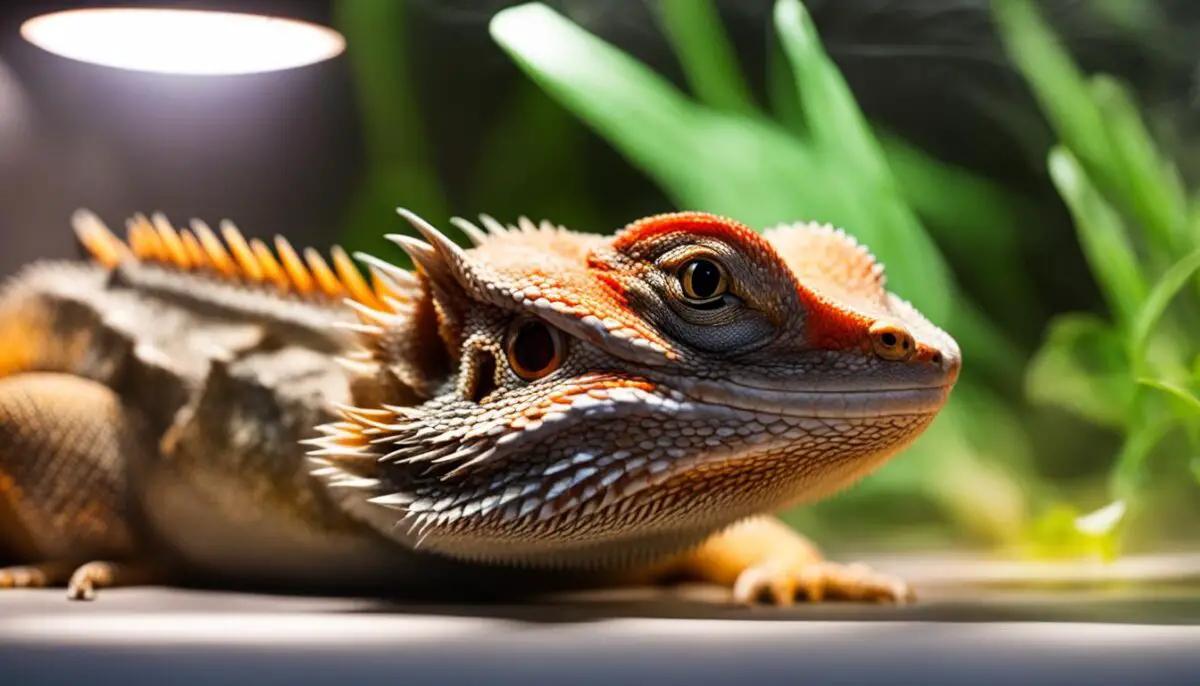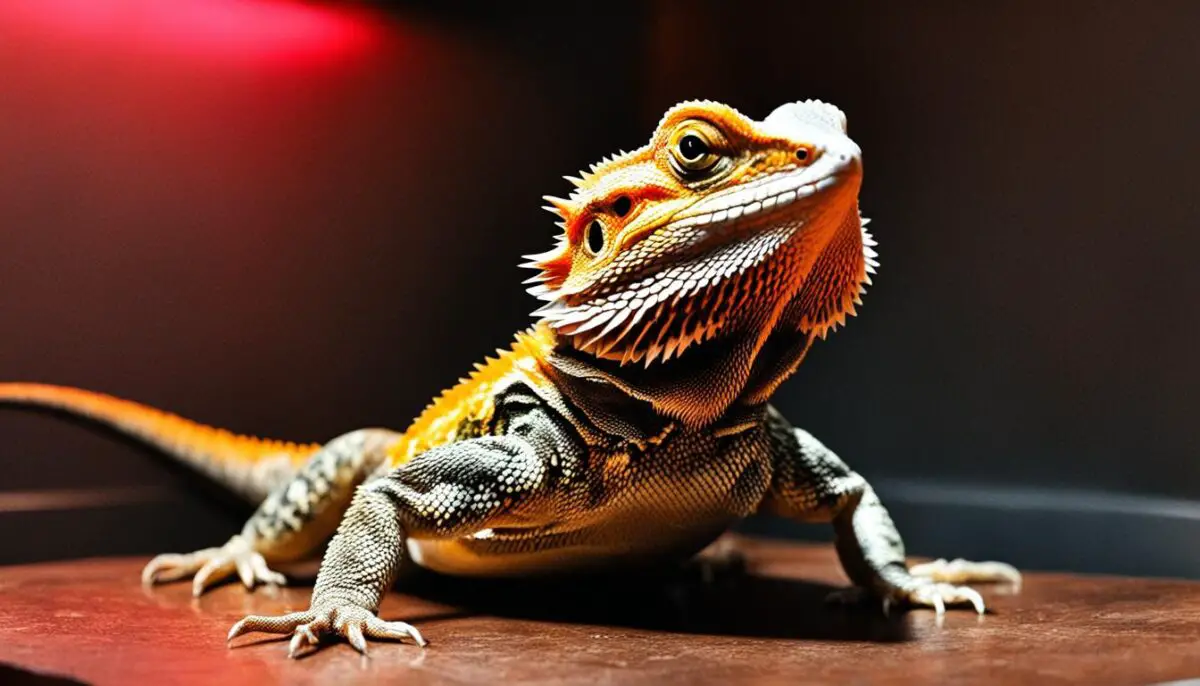Bearded dragons are the most popular pet reptiles in the world, beloved for their docile nature and unique appearance. Whether you’re a first-time bearded dragon owner or a long-time enthusiast, this comprehensive guide is here to provide you with all the essential information you need to care for your scaly companion.
From understanding the different types and morphs of bearded dragons to creating the perfect habitat and ensuring a healthy diet, this guide covers it all. Whether you’re interested in capturing their beauty through drawing, sketching, or creating stunning art, or simply looking for templates, coloring pages, or clipart, this guide has something for every bearded dragon enthusiast.
Key Takeaways:
- Bearded dragons are popular pet reptiles known for their docile nature.
- This guide covers everything from understanding different types and morphs to caring for their habitat and diet.
- Whether you’re an artist or simply looking for creative resources, this guide has you covered.
- Ensure the health and happiness of your bearded dragon with the right knowledge and commitment.
- By following this guide, you can enjoy a rewarding and fulfilling relationship with your bearded dragon.
Types of Bearded Dragons and Morphs
Bearded dragons are a diverse species with various types and morphs. Let’s explore the different species and color variations that make these reptiles so fascinating.
The Most Common Bearded Dragon Species
There are several species of bearded dragons that are legal to own as pets in the USA. Each species has its own unique characteristics and care requirements. The most common species include:
- Pogona vitticeps (Central bearded dragon): This species is the most popular pet bearded dragon, reaching lengths of over 18 inches.
- Pogona minor (Western bearded dragon): Western bearded dragons are known for their smaller size and captivating color patterns.
- Pogona barbata (Eastern bearded dragon): Eastern bearded dragons are native to Australia and are characterized by their beard display and stunning coloration.
- Pogona henrylawsoni (Rankins bearded dragon): Rankins bearded dragons are smaller in size and have a more laid-back temperament compared to other species.
Bearded Dragon Morphs
In addition to the different species, there are also various morphs of bearded dragons. Morphs are bred to exhibit specific colorations or scale patterns, resulting in a wide array of visually striking bearded dragons. It’s the morphs that truly highlight the beauty and uniqueness of these reptiles.
Did You Know? There are approximately 20 different morphs of bearded dragons, including popular variations like the Citrus, Hypo, Translucent, and Leatherback morphs.
Each morph has its own distinct appearance, with varying colors, patterns, and textures. Bearded dragon enthusiasts enjoy collecting and breeding different morphs to create fascinating combinations and explore the vast possibilities of bearded dragon genetics.

Whether you prefer the classic appearance of a specific species or the captivating allure of unique morphs, the world of bearded dragon types and morphs is sure to captivate any reptile enthusiast.
Bearded Dragon Behavior and Demeanor
Bearded dragons are renowned for their delightful and sociable nature. They are docile creatures that enjoy interacting with their owners and can be easily handled, making them excellent pets for both beginners and experienced reptile enthusiasts. However, it’s essential to understand their behavior and temperament to ensure their well-being and prevent any potential aggression.
Bearded dragons, like any other living beings, can exhibit mood swings and become aggressive if they feel threatened or if their territory is invaded. It’s crucial to provide a safe and secure environment that mimics their natural habitat to reduce any potential stressors.
Understanding the typical behaviors and body language of bearded dragons allows owners to identify signs of discomfort or aggression promptly. This knowledge helps create a nurturing environment where the dragon feels secure and relaxed.
Diurnal Creatures
Bearded dragons are diurnal creatures, meaning they are most active during the day and rest at night. In their natural habitat, they bask in the sun to regulate their body temperature and absorb essential UVB rays for their overall health. Therefore, providing them with a warm and comfortable environment with adequate lighting is crucial for their well-being and behavior.
Creating the Perfect Environment
Bearded dragons thrive in a well-equipped habitat that replicates their natural surroundings. Here are a few key considerations for maintaining their optimal environment:
- Temperature: Ensure a temperature gradient in their terrarium, with a basking area reaching 90-95°F and a cooler zone around 80-90°F. Nighttime temperatures should not drop below 70°F to avoid stress.
- Lighting: Provide appropriate lighting, including a UVB source, to facilitate proper calcium absorption and support overall health. Natural daylight bulbs or specific reptile UVB bulbs are recommended.
- Space and Enclosure: The size of the enclosure should be suitable for your bearded dragon’s adult size. Provide enough space for them to explore, bask, and have hiding spots to retreat to when needed.
- Substrate: Choose a safe and non-toxic substrate, such as reptile carpet or ceramic tiles, to avoid impaction risks associated with loose substrates like sand or gravel.
Handling and Socialization
Regular handling and socialization play vital roles in shaping a bearded dragon’s behavior and temperament. By gently handling and interacting with them from a young age, they develop trust and become comfortable with human contact. Avoid sudden movements and ensure a calm environment to prevent stress and aggression.
It’s important to remember that each bearded dragon has its own personality and may react differently to various situations. Some may be more outgoing and sociable, while others may be shy or reserved. Patience, consistency, and understanding are key to building a strong bond and maintaining a positive relationship with your bearded dragon.
“Understanding the behavior and temperament of bearded dragons is crucial for their well-being and proper care. By creating a suitable environment, being mindful of their social needs, and recognizing their unique behaviors, you can ensure a harmonious and fulfilling relationship with your scaly companion.” – Dr. Sarah Johnson, Herpetologist

| Common Behaviors | Description |
|---|---|
| Head Bobs | Bearded dragons may bob their heads as a form of communication, asserting dominance, or expressing readiness to mate. |
| Arm Waves | Arm waving is often a submissive behavior displayed when bearded dragons feel threatened or want to avoid confrontation. |
| Gaping | Gaping is a defensive display where bearded dragons open their mouths wide to intimidate potential threats. |
| Tail Twitching | Bearded dragons may twitch their tails when they are excited, stressed, or irritated. |
| Black Beard | A black beard indicates a sign of stress, aggression, or agitation. |
Basic Habitat Setup for Bearded Dragons
Creating the perfect habitat is essential for the well-being of your bearded dragon. Providing them with a comfortable and suitable environment will ensure their overall health and happiness. Here are the key elements to consider when setting up your bearded dragon’s habitat:
Lighting:
Proper lighting is crucial for the well-being of bearded dragons. They require both natural and artificial light sources to regulate their internal temperature and receive essential nutrients. Ultraviolet B (UVB) lighting is particularly important as it helps them metabolize calcium, preventing diseases like metabolic bone disease.
Temperature:
Bearded dragons are ectothermic, meaning they rely on external heat sources to regulate their body temperature. To create a suitable temperature gradient in the terrarium, place a basking spot at one end where the dragon can reach a temperature of 90-95°F (32-35°C). The rest of the habitat should have a daytime temperature between 80-90°F (27-32°C) and a nighttime temperature not lower than 70°F (21°C).
Humidity:
Maintaining the right humidity levels in your bearded dragon’s habitat is important for their overall health. The ideal humidity range for bearded dragons is between 35% and 40%. This can be achieved by misting the terrarium with water or using a reptile humidifier.
Substrate:
When choosing a substrate for your bearded dragon’s habitat, it’s essential to prioritize their safety and hygiene. Avoid using loose substrates like sand or gravel, as they can pose a risk of impaction if ingested. Instead, opt for reptile carpet, ceramic tiles, or non-adhesive shelf liners, which are easier to clean and reduce the risk of accidental ingestion.
| Element | Recommendation |
|---|---|
| Lighting | Provide both natural and artificial light sources, including UVB lighting. |
| Temperature | Create a temperature gradient with a basking spot reaching 90-95°F (32-35°C), daytime temperature of 80-90°F (27-32°C), and nighttime temperature not lower than 70°F (21°C). |
| Humidity | Maintain humidity levels between 35% and 40% by misting or using a reptile humidifier. |
| Substrate | Choose reptile carpet, ceramic tiles, or non-adhesive shelf liners to ensure safety and cleanliness. |
By creating a habitat that meets the lighting, temperature, humidity, and substrate needs of your bearded dragon, you will provide them with a comfortable and healthy living environment. Remember to regularly monitor and maintain these conditions to ensure the well-being of your beloved pet.

Bearded Dragon Diet and Feeding
Proper nutrition is essential for the health and well-being of your bearded dragon. As omnivores, bearded dragons require a balanced diet that includes both animal and plant matter. Here’s everything you need to know about feeding your bearded dragon:
1. Feeding Guidelines
When it comes to bearded dragon diet, it’s important to offer a variety of fresh vegetables, leafy greens, fruits, and live insects. This ensures that they receive all the necessary nutrients for optimal growth and development. Different stages of life require different ratios of animal protein to vegetation.
For young bearded dragons, prioritize animal protein to support their rapid growth. As they mature, gradually introduce more vegetables and greens into their diet. Adult bearded dragons should have a diet that consists of approximately 80% vegetation and 20% animal protein.
2. Live Insects
Live insects are a crucial part of a bearded dragon’s diet, providing essential protein and nutrients. Offer a variety of insects, such as crickets, dubia roaches, mealworms, and silkworms, to ensure a diverse and nutritious diet. Dust the insects with a calcium supplement before feeding them to your bearded dragon to promote bone health.
3. Vegetables and Greens
Bearded dragons should be offered a variety of fresh vegetables and leafy greens. These include collard greens, mustard greens, dandelion greens, kale, squash, bell peppers, and carrots. Aim to provide a mixture of different vegetables to ensure a well-rounded diet.
4. Fruits
While fruits should be given in moderation due to their high sugar content, they can still be a healthy addition to your bearded dragon’s diet. Offer fruits such as blueberries, raspberries, strawberries, and small pieces of apple or melon as occasional treats.
5. Feeding Schedule
Establishing a consistent feeding schedule is important for the well-being of your bearded dragon. Feed them once or twice a day, depending on their age and appetite. Young dragons may require more frequent feedings, while adults can be fed once a day. Remove any uneaten food after 15-20 minutes to prevent spoilage and maintain cleanliness in their enclosure.
6. Fresh Water
Always provide your bearded dragon with fresh, clean water. Use a shallow dish that is easy for them to access without the risk of drowning. Change the water daily to ensure its freshness.
| Vegetables and Greens | Protein | Fruits |
|---|---|---|
| Collard Greens | Crickets | Blueberries |
| Mustard Greens | Dubia Roaches | Raspberries |
| Dandelion Greens | Mealworms | Strawberries |
| Kale | Silkworms | Apple (small pieces) |
| Squash | Melon (small pieces) | |
| Bell Peppers | ||
| Carrots |
Remember to consult with a veterinarian experienced in reptile care for specific dietary recommendations based on the age, size, and health of your bearded dragon. By providing a well-balanced diet and following a consistent feeding schedule, you can ensure the optimal health and happiness of your beloved pet.

Health and Wellness of Bearded Dragons
Maintaining the health and wellness of your bearded dragon is crucial for their overall well-being. Regular veterinary check-ups are recommended to ensure proper growth, monitor their overall health, and address any potential issues early on. By prioritizing bearded dragon veterinary care, you can provide the necessary support to keep your pet healthy and happy.
Signs of a healthy bearded dragon include clear eyes, nose, ears, mouth, and cloaca. You should also observe active and inquisitive behavior, which is indicative of a thriving dragon. Regular veterinary visits allow professionals to assess these indicators, perform necessary tests, and provide guidance tailored to your dragon’s specific needs.
To maintain your bearded dragon’s hygiene and aid in shedding, regular bathing is essential. This practice ensures that your dragon’s skin remains clean and free from any potential irritants or infections. Bathing your bearded dragon not only promotes good skin health but also allows for bonding time and a chance to observe their behavior more closely.
Monitoring your bearded dragon’s weight, behavior, and physical appearance is crucial in identifying any potential health concerns. Regularly observing changes in appetite, energy levels, and droppings can provide valuable insights into their well-being. Any unusual or concerning signs should be promptly addressed with your veterinarian.
“Regular check-ups with a reptile veterinarian can help ensure the long-term health and happiness of your bearded dragon. By actively monitoring their health and wellness, you can provide the care and attention they need throughout their life.”

Common Health Issues in Bearded Dragons
| Health Concern | Symptoms | Treatment |
|---|---|---|
| Metabolic bone disease | Fragile bones, deformities, difficulty moving | Calcium and vitamin D3 supplementation, UVB exposure, dietary changes |
| Parasites | Weight loss, decreased appetite, diarrhea, lethargy | Antiparasitic medications prescribed by a veterinarian |
| Respiratory infections | Coughing, wheezing, labored breathing | Antibiotics, supportive care, maintaining optimal temperature and humidity |
| Impaction | Constipation, bloating, lack of appetite | Dietary changes, hydration support, potentially manual removal of blockage |
| Dermatitis | Redness, swelling, irritation of the skin | Topical treatments, adjusting habitat conditions, addressing potential irritants |
Being proactive in addressing your bearded dragon’s health needs is essential for their overall well-being. By partnering with a reptile veterinarian and actively monitoring their health and behavior, you can ensure that your bearded dragon enjoys a long and healthy life.
Bringing Home a Bearded Dragon
Bringing a bearded dragon home requires careful consideration. It is important to choose a reputable source, such as a specialist reptile breeder, to ensure the health and quality of the dragon. Setting up the habitat before bringing the dragon home will minimize stress and provide a smooth transition. Selecting a healthy dragon with clear signs of vitality, such as clear eyes and active behavior, is essential. A long-term commitment is necessary as bearded dragons can live for over ten years with proper care.
When adopting a bearded dragon, it’s crucial to take the time to find a reputable breeder or pet shop that specializes in reptiles. Ensuring the well-being of the dragon starts with obtaining it from a trusted source. Reputable breeders and pet shops prioritize the health and quality of their animals, ensuring that they have been bred and raised in a safe and comfortable environment. By adopting from such establishments, you can have peace of mind knowing that your new pet has received proper care and attention from the very beginning.
Before bringing your bearded dragon home, it’s important to have their habitat set up and ready to go. The habitat should mimic their natural environment as closely as possible to ensure their well-being. This involves providing the right lighting, temperature, and substrate, as well as creating spaces for them to bask and hide. By setting up the habitat in advance, you can minimize stress for your new pet and make their transition smoother.
When selecting a bearded dragon, pay close attention to their overall health and vitality. Look for clear eyes, active behavior, and an alert demeanor. Avoid dragons that show signs of illness or have any visible abnormalities. By choosing a healthy dragon, you are starting off on the right foot and setting the stage for a long and happy life together.
Bearded Dragon Care Tips
- Provide a spacious and suitable habitat
- Ensure proper lighting and temperature
- Offer a varied and nutritious diet
- Handle your bearded dragon gently and regularly to promote bonding
- Regularly clean and maintain the habitat to prevent bacteria buildup
- Monitor their behavior and health regularly
- Consult with a reptile veterinarian for regular check-ups and any concerns
By following these care tips, you can provide a happy and healthy environment for your bearded dragon and enjoy a rewarding relationship for many years to come.
Conclusion
Providing proper care and attention is essential for the health and happiness of your bearded dragon. This comprehensive guide has covered all the essential aspects of bearded dragon ownership, ensuring you have the knowledge and resources to provide the best care for your pet.
Understanding the unique needs of bearded dragons, such as creating a suitable habitat with the right lighting and temperature, and offering a balanced diet of insects and vegetables, is key to their well-being. Regular veterinary check-ups and monitoring their behavior and physical appearance can help identify any health concerns early on.
Whether you’re a seasoned bearded dragon enthusiast or a first-time owner, this guide has provided a thorough understanding of bearded dragon care, serving as a valuable resource to support your pet ownership journey. By following this guide with the right commitment, you can build a rewarding and fulfilling relationship with your beloved bearded dragon.
FAQ
What are some common types and morphs of bearded dragons?
The most common types of bearded dragons include the Pogona vitticeps (Central bearded dragon), Pogona minor (Western bearded dragon), Pogona barbata (Eastern bearded dragon), and Pogona henrylawsoni (Rankins bearded dragon). There are also around 20 different morphs, bred for specific colorations or scale patterns.
How would you describe the behavior of bearded dragons?
Bearded dragons are known for their docile and friendly nature. They enjoy interacting with their owners and are easily handled. However, they can display mood swings and become aggressive if they feel threatened or their territory is being invaded.
What is important to consider when setting up a habitat for bearded dragons?
It is important to provide proper lighting, including UVB, for essential nutrient absorption and temperature regulation. The temperature in the terrarium should have a gradient, with a basking area reaching 90-95°F, a daytime temperature of 80-90°F, and a nighttime temperature not lower than 70°F. Humidity should be maintained between 35% and 40%. The choice of substrate is also important, with options like reptile carpet or ceramic tiles being recommended over sand or gravel.
What should be included in a bearded dragon’s diet?
Bearded dragons are omnivores and require a combination of fresh vegetables, leafy greens, fruits, and live insects. The diet ratios may vary depending on their age, with young bearded dragons requiring more animal protein. It is important to provide a variety of insects and a wide range of vegetables and fruits to ensure they receive all the necessary nutrients. Feeding schedules should be consistent, with fresh water always available.
How can I ensure the health and wellness of my bearded dragon?
Regular veterinary check-ups are recommended to monitor their overall health, ensure proper growth, and address any potential issues. Signs of a healthy bearded dragon include clear eyes, nose, ears, mouth, and cloaca, as well as active and inquisitive behavior. Bathing your bearded dragon regularly is also important for hygiene and shedding. Monitoring their weight, behavior, and physical appearance can help identify any potential health concerns.
What should I consider when bringing a bearded dragon home?
It is important to choose a reputable source, such as a specialist reptile breeder, to ensure the health and quality of the dragon. Setting up the habitat before bringing the dragon home will minimize stress and provide a smooth transition. Selecting a healthy dragon with clear signs of vitality, such as clear eyes and active behavior, is essential. A long-term commitment is necessary as bearded dragons can live for over ten years with proper care.


